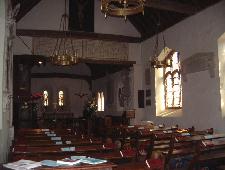
Picture by Lorna Minton www.palmito.demon.co.uk
 St James is situated in the heart of the Ruscombe Conservation Area. With a seating capacity of 80, it is used regularly for smaller Sunday services and Baptisms, while larger events and services take place at St Mary's, Twyford.
St James is situated in the heart of the Ruscombe Conservation Area. With a seating capacity of 80, it is used regularly for smaller Sunday services and Baptisms, while larger events and services take place at St Mary's, Twyford.
St James is small, light and attractive, and is popular for weddings and other special services.
St James the Great Ruscombe is an historic Grade 1 listed building originating from the 12th century. The oldest part of the church is the chancel which is built partly of flint. The nave and the tower were rebuilt almost entirely of brick in 1638. Between 1870-80 the north organ chamber was added, and there are a number of interior features that are worthy of note. There are also five listed tombs within the churchyard from the 18th and 19th centuries.
More detailed history of St James'
The first mention of Ruscombe is in 1091 in the Foundation Charter of the Cathedral of Old Sarum (Salisbury). Since the charter makes no reference to a church or chapel at Ruscombe, it seems unlikely that one then existed. It was 130 years later, in 1220, that the existence of a chapel in Ruscombe, then within the parish of Sonning, was first mentioned. It seems probable therefore that this chapel at Ruscombe was built sometime between 1091 and 1185. The chancel walls of the present church are the original walls, with the original lancet windows in the east and north walls. The window on the south wall of the chancel has subsequently been enlarged to let in more light.
Faded paintings in the splays of the east wall windows are thought to date from the 13th century. One is clearly of St Peter equipped with a large key. It is less clear which saints the other paintings represent.

There is a small piscina located on the south wall of the chapel, which would have been used in Pre-Reformation times for cleaning the scared vessels after Mass. This area was bricked over at the time of the Reformation, and was rediscovered during restoration work in 1984. Also discovered at that time were two plain rectangular shaped recesses in the north and east walls, one of which would certainly have been an aumbry (i.e. cupboard) for storing sacred vessels.
Almost certainly there was once a rood screen separating the chancel from the nave, although this was probably destroyed in the late 16th century. In the same period the words of the Ten Commandments were added to the chancel beam by order of Queen Elizabeth 1st in that this should be done in parish churches. They were cleaned and restored in 1990.
The present nave and tower date from 1638/9. On the walls are several monumental tablets of the 17th to 20th centuries to the memory of local families, the Allworths, Nevilles and Barkers. The most impressive of these is located on the north wall of the nave, in memory of Sir James Eyre, Lord Chief Justice of the Court of Common Pleas who died in 1799. The inscriptions indicate that people were buried under the floor of the chancel. This was confirmed during the course of essential repairs to the subsiding chancel floor in 1992, when 13 lead linings of coffins were discovered, along with corroded coffin handles, plates and nails, and a considerable quantity of human remains.
The tower houses a pair of bells: a tenor bell cast in the 16th century at one of Reading’s bell foundries; and a treble bell, probably cast at the Wokingham bell foundry early in the 15th century.
The clock located on the outside west wall of the tower was installed in 1920 to commemorate those sons of Ruscombe who fell in the 1914 -18 war. It was funded by Ruscombe Parish council, who in partnership with St James, continue to pay for it to be maintained on alternative year basis.
St James the Great Church is a Grade 1 listed building, which has received financial support and advice from English Heritage. It is loved and cared for by an active congregation, and is popular for weddings and other special services. A booklet is available from church (price £1) giving more detailed information about this church's history.